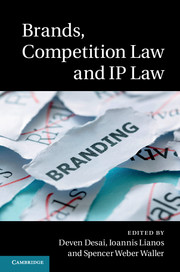Book contents
- Frontmatter
- Contents
- List of figures
- List of tables
- List of contributors
- Introduction
- PART I Brands, price theory and business studies' perspectives
- PART II Brands and competition law
- 4 Brands, competition, and antitrust law
- 5 Brands and brand management: insights from marketing for antitrust
- 6 Brands and market power: a bird's-eye view
- 7 The two sides of brand marketing: reconsidering competition law governing distribution restraints
- 8 Brands, product differentiation and EU competition law
- 9 Private labels, brands and competition law enforcement
- PART III Brands and IP law
- Index
7 - The two sides of brand marketing: reconsidering competition law governing distribution restraints
from PART II - Brands and competition law
Published online by Cambridge University Press: 05 August 2015
- Frontmatter
- Contents
- List of figures
- List of tables
- List of contributors
- Introduction
- PART I Brands, price theory and business studies' perspectives
- PART II Brands and competition law
- 4 Brands, competition, and antitrust law
- 5 Brands and brand management: insights from marketing for antitrust
- 6 Brands and market power: a bird's-eye view
- 7 The two sides of brand marketing: reconsidering competition law governing distribution restraints
- 8 Brands, product differentiation and EU competition law
- 9 Private labels, brands and competition law enforcement
- PART III Brands and IP law
- Index
Summary
Introduction
As a participant in an international intellectual property conference in the late 1970s, I had occasion to exchange thoughts about brand marketing with a Russian academic. As he described the distribution system in a socialist economy dominated by state-owned enterprises, there was little place for branded products. Yet, he pointed out, Russian consumers wanted the information that branding could provide. According to my colleague, savvy consumers in his country knew that a particular state enterprise in Kiev made comfortable and well-constructed shoes. Armed with this knowledge, consumers would inquire of their local shoe store when the next shipment of shoes from Kiev would arrive. Lines often formed when the word got out that the preferred shoes were available.
This story from the Soviet Union, it turns out, says a lot about why branding is an essential part of modern, efficient marketing. Without brands, consumers struggle to learn about reputation and quality. Producers who make a quality product, for their part, struggle to get that information out to the buying public. Once a product is branded, the producer has an incentive to use advertising to promote a brand's qualities. Indeed, word of mouth may allow the brand to sell itself. The producer can expand production to achieve economies of scale, and the consumer can more comfortably trust that the producer's incentive to maintain brand reputation will assure a quality product. That is brand marketing at its best – as it should work.
There is, however, a darker side. Exaggeration, obfuscation, and even outright deceit have long been associated with the sale of some branded products. The marketing of patent medicines in the late nineteenth and early twentieth centuries is an example. Most of these medications were not patented, although their ingredients, which often included alcohol, opiates, or both, were kept secret from buyers. Advertising was intense, and laced with hyperbole and unsubstantiated claims about curative effects, but silent about ingredients. By 1906 investigative reports of ill effects and even death caused by consumption of these medications, along with Upton Sinclair's novel about meat packing abuses, prompted Congress to enact the Pure Food and Drug Act.
- Type
- Chapter
- Information
- Brands, Competition Law and IP , pp. 138 - 145Publisher: Cambridge University PressPrint publication year: 2015



